Finance Everywhere, Member Exclusive
Embedded Finance Briefing: Plaid acquires Cognito to enhance onboarding capabilities
- This week, we look at Plaid's acquisition of identity verification and compliance platform Cognito, in a deal valued around $250 million.
- Plaid putting the pieces together for a complete onboarding program.








